EC
-
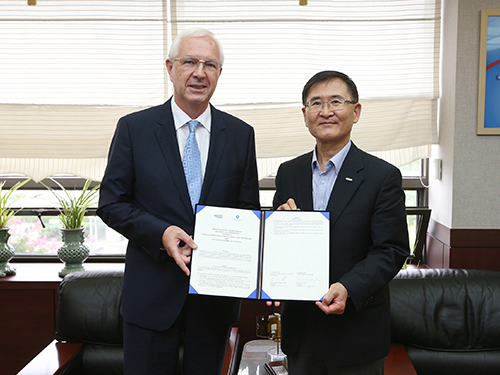 KAIST and the Czech Academy of Sciences Agree to Cooperate
KAIST and the Czech Academy of Sciences (CAS) signed a memorandum of understanding in the office of KAIST’s president on August 11, 2015. Ten people from the two institutions, including President Steve Kang of KAIST and Chairman Jiří Drahoš of CAS participated in the signing ceremony.
Under the agreement, the two institutions will cooperate on establishing joint research programs, sharing up-to-date research outcomes, and medium-and long-term exchange of researchers.
Having more than 50 public laboratories all over the Czech Republic, the Czech Academy of Sciences is the largest research institution in the country. Its research body along with the staff has eight thousand members. The institution focuses on mathematics, physics, biotechnology, and social sciences while running its own Ph.D. program.
President Kang said, “I hope this signing will expand our cooperation with universities and research institutions in Eastern Europe.”
2015.08.18 View 4709
KAIST and the Czech Academy of Sciences Agree to Cooperate
KAIST and the Czech Academy of Sciences (CAS) signed a memorandum of understanding in the office of KAIST’s president on August 11, 2015. Ten people from the two institutions, including President Steve Kang of KAIST and Chairman Jiří Drahoš of CAS participated in the signing ceremony.
Under the agreement, the two institutions will cooperate on establishing joint research programs, sharing up-to-date research outcomes, and medium-and long-term exchange of researchers.
Having more than 50 public laboratories all over the Czech Republic, the Czech Academy of Sciences is the largest research institution in the country. Its research body along with the staff has eight thousand members. The institution focuses on mathematics, physics, biotechnology, and social sciences while running its own Ph.D. program.
President Kang said, “I hope this signing will expand our cooperation with universities and research institutions in Eastern Europe.”
2015.08.18 View 4709 -
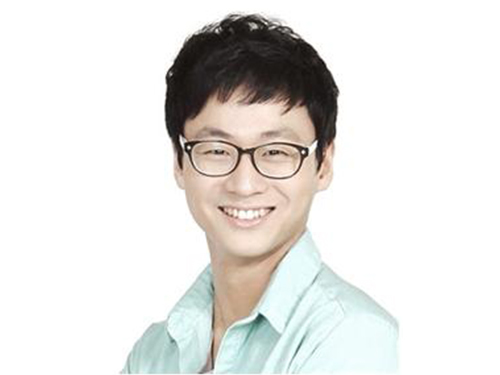 Dr. Hyundoo Hwang Receives a Tenured Position at Monterrey Institute of Technology and Higher Education
Hyundoo Hwang, a former graduate student in the Department of Bio & Brain Engineering at KAIST, has been granted a tenured position at the Monterrey Institute of Technology and Higher Education (ITSEM), Mexico.
Dr. Hwang received his bachelor’s, master’s, and doctoral degree at KAIST and started his professorship at Ulsan National Institute of Science & Technology (UNIST) in Korea. He continued his research in the United States as a professor at Georgia Institute of Technology. He has been acknowledged for the development of an advanced nanotechnology for the diagnosis of rare diseases and research in cell signals. He is one of the leading researchers in an international research project in microelectromechanical systems (MEMS) with participation by researchers from over ten countries. He has been active in commercializing biosensor technology in the U.S. and Mexico.
Since its establishment in 1943, ITSEM has grown to 33 campuses in 25 cities in Mexico. It is the largest university in Latin America with over 90,000 students (47% of its graduate students has oversea research experience). It recruits over 5,000 international students and professors every year.
Dr. Hwang will begin teaching at ITSEM as a professor in the Department of Biomedical Engineering (Ingeniería Biomédica) this fall. He will also conduct research in nano- and micro-technology as a member of Sensors and Devices research group.
Professor Gwang Hyun Cho, head of KAIST's Department of Bio and Brain Engineering said that Dr. Hwang’s tenure professorship at ITSEM demonstrated that the academic program at KAIST—from undergraduate to doctoral—was on par with the international standard. He hoped that more talents from the department would seek academic careers in internationally renowned universities around the world.
2015.08.13 View 7077
Dr. Hyundoo Hwang Receives a Tenured Position at Monterrey Institute of Technology and Higher Education
Hyundoo Hwang, a former graduate student in the Department of Bio & Brain Engineering at KAIST, has been granted a tenured position at the Monterrey Institute of Technology and Higher Education (ITSEM), Mexico.
Dr. Hwang received his bachelor’s, master’s, and doctoral degree at KAIST and started his professorship at Ulsan National Institute of Science & Technology (UNIST) in Korea. He continued his research in the United States as a professor at Georgia Institute of Technology. He has been acknowledged for the development of an advanced nanotechnology for the diagnosis of rare diseases and research in cell signals. He is one of the leading researchers in an international research project in microelectromechanical systems (MEMS) with participation by researchers from over ten countries. He has been active in commercializing biosensor technology in the U.S. and Mexico.
Since its establishment in 1943, ITSEM has grown to 33 campuses in 25 cities in Mexico. It is the largest university in Latin America with over 90,000 students (47% of its graduate students has oversea research experience). It recruits over 5,000 international students and professors every year.
Dr. Hwang will begin teaching at ITSEM as a professor in the Department of Biomedical Engineering (Ingeniería Biomédica) this fall. He will also conduct research in nano- and micro-technology as a member of Sensors and Devices research group.
Professor Gwang Hyun Cho, head of KAIST's Department of Bio and Brain Engineering said that Dr. Hwang’s tenure professorship at ITSEM demonstrated that the academic program at KAIST—from undergraduate to doctoral—was on par with the international standard. He hoped that more talents from the department would seek academic careers in internationally renowned universities around the world.
2015.08.13 View 7077 -
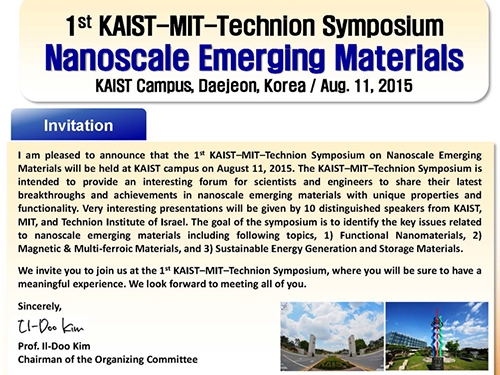 KAIST holds the 2015 KAIST-MIT-Technion International Symposium on Nano Science
The 2015 KAIST-MIT-Technion International Symposium on Nano Science was held on August 11, 2015 at the KAIST campus. The event took place under three subtopics: Materials for Production and Storage of Renewable Energy, Functional Materials, and Multiferroic Materials.
The joint symposium invited more than 300 experts in material science and engineering including ten speakers and panelists. From MIT (Massachusetts Institute of Technology), Professors Harry L. Tuller and Geoffrey S. Beach in the Department of Material Engineering, as well as Professor Gregory Rutledge in the Department of Chemical Engineering joined the symposium. Professor Avner Rothschild in the Department of Material Engineering and Professor Yair Ein-Eli in the Department of Chemical Engineering at Technion Institute of Technology in Israel also participated.
From KAIST, Professors Il-Doo Kim, Byong-Guk Park, and Yeon-Sik Jung in the Department of Materials Science and Engineering, Professor Chan-Ho Yang in the Department of Physics, and Professor Doh-Chang Lee in the Department of Chemical and Biomolecular Engineering spoke at the event. The list of topics included “Next Generation Lithium-Air Battery,” “Nano Materials for High Performance Energy Storage System,” and “Iron Oxide Nanoparticles Photoelectrode for the Conversion and Storage of Solar Energy.”
In its efforts to promote cooperation among the three universities, KAIST plans to send six students to MIT and one student to Technion for joint research.
Professor Il-Doo Kim, who organized the symposium said, “We believe this kind of international gathering will serve as an opportunity for scholars from leading universities to share their expertise in material science and help them better understand on the recent trends in nanoscience and its related technology.”
2015.08.12 View 8754
KAIST holds the 2015 KAIST-MIT-Technion International Symposium on Nano Science
The 2015 KAIST-MIT-Technion International Symposium on Nano Science was held on August 11, 2015 at the KAIST campus. The event took place under three subtopics: Materials for Production and Storage of Renewable Energy, Functional Materials, and Multiferroic Materials.
The joint symposium invited more than 300 experts in material science and engineering including ten speakers and panelists. From MIT (Massachusetts Institute of Technology), Professors Harry L. Tuller and Geoffrey S. Beach in the Department of Material Engineering, as well as Professor Gregory Rutledge in the Department of Chemical Engineering joined the symposium. Professor Avner Rothschild in the Department of Material Engineering and Professor Yair Ein-Eli in the Department of Chemical Engineering at Technion Institute of Technology in Israel also participated.
From KAIST, Professors Il-Doo Kim, Byong-Guk Park, and Yeon-Sik Jung in the Department of Materials Science and Engineering, Professor Chan-Ho Yang in the Department of Physics, and Professor Doh-Chang Lee in the Department of Chemical and Biomolecular Engineering spoke at the event. The list of topics included “Next Generation Lithium-Air Battery,” “Nano Materials for High Performance Energy Storage System,” and “Iron Oxide Nanoparticles Photoelectrode for the Conversion and Storage of Solar Energy.”
In its efforts to promote cooperation among the three universities, KAIST plans to send six students to MIT and one student to Technion for joint research.
Professor Il-Doo Kim, who organized the symposium said, “We believe this kind of international gathering will serve as an opportunity for scholars from leading universities to share their expertise in material science and help them better understand on the recent trends in nanoscience and its related technology.”
2015.08.12 View 8754 -
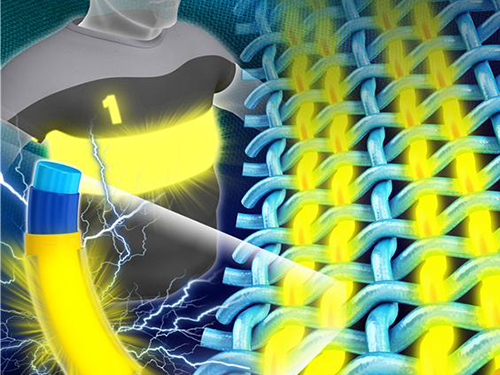 KAIST Develops Fiber-Like Light-Emitting Diodes for Wearable Displays
Professor Kyung-Cheol Choi and his research team from the School of Electrical Engineering at KAIST have developed fiber-like light-emitting diodes (LEDs), which can be applied in wearable displays. The research findings were published online in the July 14th issue of Advanced Electronic Materials.
Traditional wearable displays were manufactured on a hard substrate, which was later attached to the surface of clothes. This technique had limited applications for wearable displays because they were inflexible and ignored the characteristics of fabric.
To solve this problem, the research team discarded the notion of creating light-emitting diode displays on a plane. Instead, they focused on fibers, a component of fabrics, and developed a fiber-like LED that shared the characteristics of both fabrics and displays.
The essence of this technology, the dip-coating process, is to immerse and extract a three dimensional (3-D) rod (a polyethylene terephthalate fiber) from a solution, which functions like thread. Then, the regular levels of organic materials are formed as layers on the thread.
The dip-coating process allows the layers of organic materials to be easily created on the fibers with a 3-D cylindrical structure, which had been difficult in existing processes such as heat-coating process. By controlling of the withdrawal rate of the fiber, the coating's thickness can also be adjusted to the hundreds of thousandths of a nanometer.
The researchers said that this technology would accelerate the commercialization of fiber-based wearable displays because it offers low-cost mass production using roll-to-roll processing, a technology applied to create electronic devices on a roll of flexible plastics or metal foils.
Professor Choi said, “Our research will become a core technology in developing light emitting diodes on fibers, which are fundamental elements of fabrics. We hope we can lower the barrier of wearable displays entering the market.”
The lead author of the published paper, Seon-Il Kwon, added, “This technology will eventually allow the production of wearable displays to be as easy as making clothes.”
Picture 1: The Next Generation Wearable Display Using Fiber-Based Light-Emitting Diodes
Picture 2: Dip-Coating Process to Create Fiber-Based Light-Emitting Diodes
Picture 3: Fiber-Based Light-Emitting Diodes
2015.08.11 View 13384
KAIST Develops Fiber-Like Light-Emitting Diodes for Wearable Displays
Professor Kyung-Cheol Choi and his research team from the School of Electrical Engineering at KAIST have developed fiber-like light-emitting diodes (LEDs), which can be applied in wearable displays. The research findings were published online in the July 14th issue of Advanced Electronic Materials.
Traditional wearable displays were manufactured on a hard substrate, which was later attached to the surface of clothes. This technique had limited applications for wearable displays because they were inflexible and ignored the characteristics of fabric.
To solve this problem, the research team discarded the notion of creating light-emitting diode displays on a plane. Instead, they focused on fibers, a component of fabrics, and developed a fiber-like LED that shared the characteristics of both fabrics and displays.
The essence of this technology, the dip-coating process, is to immerse and extract a three dimensional (3-D) rod (a polyethylene terephthalate fiber) from a solution, which functions like thread. Then, the regular levels of organic materials are formed as layers on the thread.
The dip-coating process allows the layers of organic materials to be easily created on the fibers with a 3-D cylindrical structure, which had been difficult in existing processes such as heat-coating process. By controlling of the withdrawal rate of the fiber, the coating's thickness can also be adjusted to the hundreds of thousandths of a nanometer.
The researchers said that this technology would accelerate the commercialization of fiber-based wearable displays because it offers low-cost mass production using roll-to-roll processing, a technology applied to create electronic devices on a roll of flexible plastics or metal foils.
Professor Choi said, “Our research will become a core technology in developing light emitting diodes on fibers, which are fundamental elements of fabrics. We hope we can lower the barrier of wearable displays entering the market.”
The lead author of the published paper, Seon-Il Kwon, added, “This technology will eventually allow the production of wearable displays to be as easy as making clothes.”
Picture 1: The Next Generation Wearable Display Using Fiber-Based Light-Emitting Diodes
Picture 2: Dip-Coating Process to Create Fiber-Based Light-Emitting Diodes
Picture 3: Fiber-Based Light-Emitting Diodes
2015.08.11 View 13384 -
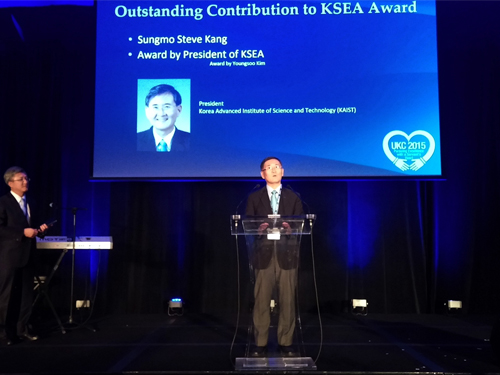 President Steve Kang of KAIST Receives the Outstanding Contribution Award from the Korean-American Scientists and Engineers Association
The Korean-American Scientists and Engineers Association (KSEA), a non-profit Korean professional organization based in the United States with over 6,000 registered members, bestowed upon President Steve Kang of KAIST the 2015 Outstanding Contribution Award.
The award is presented to a person who has made significant contributions to the development of KSEA.
The award ceremony took place during the 2015 US-Korea Conference on Science, Technology, and Entrepreneurship (UKC), which was held on July 30, 2015, at the Hyatt Regency Hotel in Atlanta, Georgia.
The UKC is the flagship conference of KSEA, which takes place every year, and covers science, engineering, technology, industry, entrepreneurship, and leadership. It attracts more than 1,200 participants from the US and Korea. The UKC 2015 was held on July 29-August 1, 2015.
President Kang has participated in UKC conferences over the past few years as a plenary speaker, addressing major issues in science and technology for both nations, and provided generous support for the activities of UKC and KSEA. He also promoted discussions and exchanges of professional knowledge in his field, microelectronics, by organizing fora and symposia.
He addressed the UKC 2015 as a plenary speaker with a speech entitled “Pursuing Excellence with a Servant’s Heart.” President Kang said that good leadership should bring out synergistic contributions from all constituents and achieve excellence under all circumstances. He mentioned one example of good leadership, known as humble leadership, and explained how such leadership played an important role in the development of scientific breakthroughs, such as the world’s premier high-end microprocessor chip sets first produced by his team under extremely high pressure.
2015.08.05 View 7847
President Steve Kang of KAIST Receives the Outstanding Contribution Award from the Korean-American Scientists and Engineers Association
The Korean-American Scientists and Engineers Association (KSEA), a non-profit Korean professional organization based in the United States with over 6,000 registered members, bestowed upon President Steve Kang of KAIST the 2015 Outstanding Contribution Award.
The award is presented to a person who has made significant contributions to the development of KSEA.
The award ceremony took place during the 2015 US-Korea Conference on Science, Technology, and Entrepreneurship (UKC), which was held on July 30, 2015, at the Hyatt Regency Hotel in Atlanta, Georgia.
The UKC is the flagship conference of KSEA, which takes place every year, and covers science, engineering, technology, industry, entrepreneurship, and leadership. It attracts more than 1,200 participants from the US and Korea. The UKC 2015 was held on July 29-August 1, 2015.
President Kang has participated in UKC conferences over the past few years as a plenary speaker, addressing major issues in science and technology for both nations, and provided generous support for the activities of UKC and KSEA. He also promoted discussions and exchanges of professional knowledge in his field, microelectronics, by organizing fora and symposia.
He addressed the UKC 2015 as a plenary speaker with a speech entitled “Pursuing Excellence with a Servant’s Heart.” President Kang said that good leadership should bring out synergistic contributions from all constituents and achieve excellence under all circumstances. He mentioned one example of good leadership, known as humble leadership, and explained how such leadership played an important role in the development of scientific breakthroughs, such as the world’s premier high-end microprocessor chip sets first produced by his team under extremely high pressure.
2015.08.05 View 7847 -
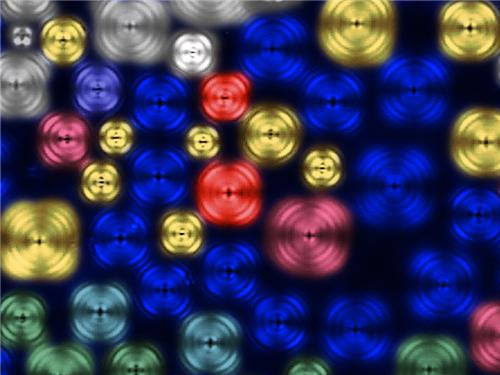 Dr. Se-Jung Kim Receives the Grand Prize at the International Photo and Image Contest on Light
Dr. Se-Jung Kim of the Physics Department at KAIST received the Grand Prize at the 2015 Photo and Image Contest of the International Year of Light and Light-based Technologies.
The United Nations has designated the year 2015 as the International Year of Light and Light-based Technologies.
The Optical Society of Korea celebrated the UN’s designation by hosting an international photo and image contest on the theme of light and optics related technology.
Dr. Kim presented a photo of images taken from a liquid crystal, which was entitled “A Micro Pinwheel.” She took pictures of liquid crystal images with a polarizing microscope and then colored the pictures. The liquid crystal has self-assembled circle domain structures, and each domain can form vortex optics. Her adviser for the project is Professor Yong-Hoon Cho of the Physics Department.
Her work was exhibited during the annual conference of the Optical Society of Korea, which was held on July 13-15, 2015 at Gyeong-Ju Hwabaek International Convention Center. It will also be exhibited at the National Science Museum in Gwacheon and the Kim Dae-Jung Convention Center in Gwangju.
Picture: A Micro Pinwheel
2015.07.31 View 10488
Dr. Se-Jung Kim Receives the Grand Prize at the International Photo and Image Contest on Light
Dr. Se-Jung Kim of the Physics Department at KAIST received the Grand Prize at the 2015 Photo and Image Contest of the International Year of Light and Light-based Technologies.
The United Nations has designated the year 2015 as the International Year of Light and Light-based Technologies.
The Optical Society of Korea celebrated the UN’s designation by hosting an international photo and image contest on the theme of light and optics related technology.
Dr. Kim presented a photo of images taken from a liquid crystal, which was entitled “A Micro Pinwheel.” She took pictures of liquid crystal images with a polarizing microscope and then colored the pictures. The liquid crystal has self-assembled circle domain structures, and each domain can form vortex optics. Her adviser for the project is Professor Yong-Hoon Cho of the Physics Department.
Her work was exhibited during the annual conference of the Optical Society of Korea, which was held on July 13-15, 2015 at Gyeong-Ju Hwabaek International Convention Center. It will also be exhibited at the National Science Museum in Gwacheon and the Kim Dae-Jung Convention Center in Gwangju.
Picture: A Micro Pinwheel
2015.07.31 View 10488 -
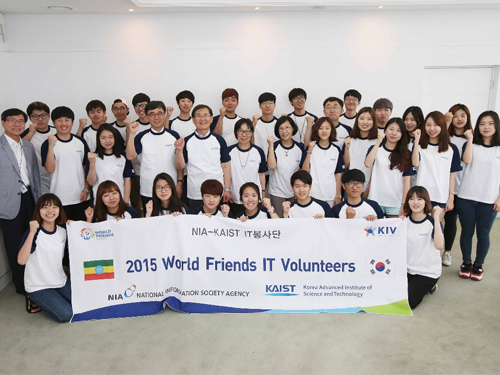 KAIST Undergraduate Students Volunteer in Ethiopia
World Friends (WF), one of the undergraduate student clubs at KAIST, offer students opportunities to volunteer in underdeveloped regions and countries. This year the World Friends team travels to Ethiopia from July 9 to August 17, 2015.
The aim of this trip is to help Ethiopian students fill gaps in their knowledge of information technology and encourage KAIST students build leadership skills through volunteer activities. Twenty-eight students will make the trip.
KAIST students will visit the Addis Ababa Institute of Technology and the Adama Science and Technology University, as well as some local high and elementary schools in Addis Ababa, where they will run computer classes related to the basics of information technology such as C Language, Java Programming, Photoshop, MS Office, and Windows.
The volunteers will offer Adama Science and Technology University students an advanced computer course to prepare them to participate in the ACM-ICPC, an international computer programming competition for university students.
KAIST students will also introduce Korean culture to Ethiopian students including K-pop, Korean cuisine and fashion, Korean language lessons, and traditional Korean art.
The Dean of Student Affairs and Policy at KAIST, Professor Young-Hee Kim said, “I hope the students from two very different cultures will cherish this opportunity to interact with each other and contribute to narrowing down the regional disparities in the IT field.”
2015.07.10 View 8567
KAIST Undergraduate Students Volunteer in Ethiopia
World Friends (WF), one of the undergraduate student clubs at KAIST, offer students opportunities to volunteer in underdeveloped regions and countries. This year the World Friends team travels to Ethiopia from July 9 to August 17, 2015.
The aim of this trip is to help Ethiopian students fill gaps in their knowledge of information technology and encourage KAIST students build leadership skills through volunteer activities. Twenty-eight students will make the trip.
KAIST students will visit the Addis Ababa Institute of Technology and the Adama Science and Technology University, as well as some local high and elementary schools in Addis Ababa, where they will run computer classes related to the basics of information technology such as C Language, Java Programming, Photoshop, MS Office, and Windows.
The volunteers will offer Adama Science and Technology University students an advanced computer course to prepare them to participate in the ACM-ICPC, an international computer programming competition for university students.
KAIST students will also introduce Korean culture to Ethiopian students including K-pop, Korean cuisine and fashion, Korean language lessons, and traditional Korean art.
The Dean of Student Affairs and Policy at KAIST, Professor Young-Hee Kim said, “I hope the students from two very different cultures will cherish this opportunity to interact with each other and contribute to narrowing down the regional disparities in the IT field.”
2015.07.10 View 8567 -
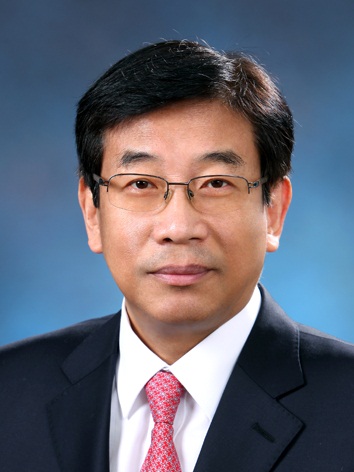 Professor Jae Kyu Lee Appointed the President of Association for Information Systems
Chair Professor Jae Kyu Lee of KAIST’s College of Business was appointed the President of Association for Information Systems (AIS) on July 1, 2015. Professor Lee will serve a one-year term, which will end in June 2016. With four thousand members researching information systems from 90 different nations, AIS is the largest academic society in the fields of information system and business process engineering.
Professor Lee has proposed his idea of “the Bright Internet” as the official vision of AIS. Employing this vision, AIS will create technology and systems, as well as sponsor international cooperation to solve fundamental issues of the Internet including concerns over hacking and cyber-related crimes.
The extent of damage from cyber-related crimes grows each year. Every day, 56 billion junk emails are sent to computers which are hacked and become “zombie” computers. The social cost of such crimes is estimated to be 400 billion US dollars annually.
Based on "the Bright Internet," AIS will build a preventative Internet security system by adopting ground rules that make attackers responsible for the damages from such crimes. The system will also modify technology and other systems to minimize privacy infringement while maintaining security. Finally, the Bright Internet proposes to adopt an international standard for this security system through collaboration with the International Telecommunications Union (ITU).
Professor Lee said, “The vision of the Bright Internet started from an awareness that we needed to resolve issues such as Internet addiction, indiscriminate media exposure, and verbal violence. This vision developed by the experts from all around the world will not only bring a revolution of a reliable Internet platform to a global scale but also reshape the Korean Internet platform.”
2015.07.02 View 8017
Professor Jae Kyu Lee Appointed the President of Association for Information Systems
Chair Professor Jae Kyu Lee of KAIST’s College of Business was appointed the President of Association for Information Systems (AIS) on July 1, 2015. Professor Lee will serve a one-year term, which will end in June 2016. With four thousand members researching information systems from 90 different nations, AIS is the largest academic society in the fields of information system and business process engineering.
Professor Lee has proposed his idea of “the Bright Internet” as the official vision of AIS. Employing this vision, AIS will create technology and systems, as well as sponsor international cooperation to solve fundamental issues of the Internet including concerns over hacking and cyber-related crimes.
The extent of damage from cyber-related crimes grows each year. Every day, 56 billion junk emails are sent to computers which are hacked and become “zombie” computers. The social cost of such crimes is estimated to be 400 billion US dollars annually.
Based on "the Bright Internet," AIS will build a preventative Internet security system by adopting ground rules that make attackers responsible for the damages from such crimes. The system will also modify technology and other systems to minimize privacy infringement while maintaining security. Finally, the Bright Internet proposes to adopt an international standard for this security system through collaboration with the International Telecommunications Union (ITU).
Professor Lee said, “The vision of the Bright Internet started from an awareness that we needed to resolve issues such as Internet addiction, indiscriminate media exposure, and verbal violence. This vision developed by the experts from all around the world will not only bring a revolution of a reliable Internet platform to a global scale but also reshape the Korean Internet platform.”
2015.07.02 View 8017 -
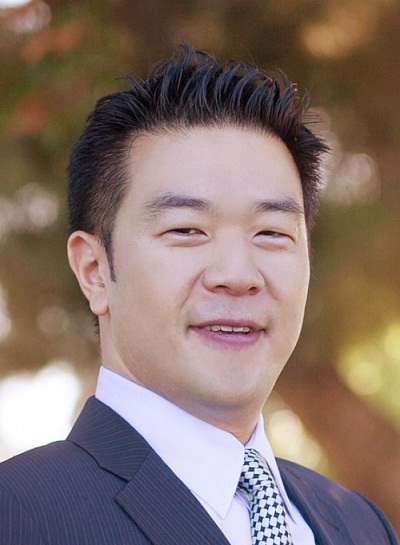 KAIST Professor Sung-Ju Lee Appointed a Technical Program Chair of INFOCOM
Professor Sung-Ju Lee of the Department of Computer Science at KAIST has been appointed to serve as a technical program chair of IEEE INFOCOME. The computer communication conference, started in 1982, is influential in the research fields of the Internet, wireless, and data centers.
Professor Lee is the first Korean to serve as a program chair. He has been acknowledged for his work in network communications. In the 34th conference, which will be held next year, he will take part in selecting 650 experts in the field to become members and supervise the evaluation of around 1,600 papers.
Professor Lee is the leading researcher in the field of wireless mobile network systems. He is a fellow of the Institute of Electrical and Electronics Engineers (IEEE) and served as the general chair of the 20th Association for Computing Machinery (ACM) SIGMOBILE Annual International Conference on Mobile Computing & Networking (MobiCom 2014). He is on the editorial boards of IEEE Transactions on Mobile Computing (TMC) and IEEE Internet of Things Journals.
Professor Lee said, “I hope to continue the traditions of the conference, as well as integrating research from various areas of network communication. I will strive to create a program with high technology transfer probability.”
The 34th IEEE INFOCOM will take place in San Francisco in April 2016.
2015.07.02 View 8852
KAIST Professor Sung-Ju Lee Appointed a Technical Program Chair of INFOCOM
Professor Sung-Ju Lee of the Department of Computer Science at KAIST has been appointed to serve as a technical program chair of IEEE INFOCOME. The computer communication conference, started in 1982, is influential in the research fields of the Internet, wireless, and data centers.
Professor Lee is the first Korean to serve as a program chair. He has been acknowledged for his work in network communications. In the 34th conference, which will be held next year, he will take part in selecting 650 experts in the field to become members and supervise the evaluation of around 1,600 papers.
Professor Lee is the leading researcher in the field of wireless mobile network systems. He is a fellow of the Institute of Electrical and Electronics Engineers (IEEE) and served as the general chair of the 20th Association for Computing Machinery (ACM) SIGMOBILE Annual International Conference on Mobile Computing & Networking (MobiCom 2014). He is on the editorial boards of IEEE Transactions on Mobile Computing (TMC) and IEEE Internet of Things Journals.
Professor Lee said, “I hope to continue the traditions of the conference, as well as integrating research from various areas of network communication. I will strive to create a program with high technology transfer probability.”
The 34th IEEE INFOCOM will take place in San Francisco in April 2016.
2015.07.02 View 8852 -
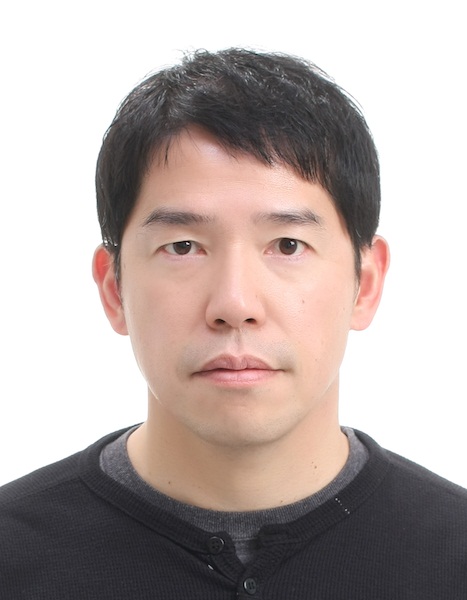 Professor Naehyuck Jang was Appointed Technical Program Chair of the Design Automation Conference
Professor Naehyuck Jang of the Electrical Engineering Department at KAIST was appointed as the technical program chair of the Design Automation Conference (DAC). He is the first Asian to serve the conference as the chair. At next year’s conference, he will select 150 program committee members and supervise the selection process of 1,000 papers.
Founded in 1964, DAC encompasses research related to automation of semiconductor processes, which usually involve billions of transistors. More than seven thousand people and 150 companies from all around the world participate, of which only the top 20% of the submitted papers are selected. It is the most prestigious conference in the field of semiconductor automation.
The Design Automation Conference also introduces optimization and automation of design processes of systems, hardware security, automobiles, and the Internet of things. Professor Jang specializes in low power system designs. As an ACM Distinguished Scientist, Professor Jang was elected as the chairman after contributing to this year’s program committee by reforming the process of selection of papers.
Professor Jang said, “This year’s conference represents a departure, where we move from the field of traditional semiconductors to the optimization of embedded system, the Internet of things, and security. He added that “we want to create a paper selection process that can propose the future of design automation.”
The 53rd annual DAC will take place at the Austin Convention Center in Texas in June 2016.
2015.07.02 View 7225
Professor Naehyuck Jang was Appointed Technical Program Chair of the Design Automation Conference
Professor Naehyuck Jang of the Electrical Engineering Department at KAIST was appointed as the technical program chair of the Design Automation Conference (DAC). He is the first Asian to serve the conference as the chair. At next year’s conference, he will select 150 program committee members and supervise the selection process of 1,000 papers.
Founded in 1964, DAC encompasses research related to automation of semiconductor processes, which usually involve billions of transistors. More than seven thousand people and 150 companies from all around the world participate, of which only the top 20% of the submitted papers are selected. It is the most prestigious conference in the field of semiconductor automation.
The Design Automation Conference also introduces optimization and automation of design processes of systems, hardware security, automobiles, and the Internet of things. Professor Jang specializes in low power system designs. As an ACM Distinguished Scientist, Professor Jang was elected as the chairman after contributing to this year’s program committee by reforming the process of selection of papers.
Professor Jang said, “This year’s conference represents a departure, where we move from the field of traditional semiconductors to the optimization of embedded system, the Internet of things, and security. He added that “we want to create a paper selection process that can propose the future of design automation.”
The 53rd annual DAC will take place at the Austin Convention Center in Texas in June 2016.
2015.07.02 View 7225 -
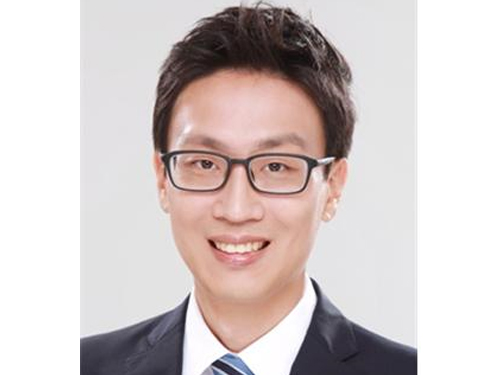 Professor Kyoungsik Yu Receives the Young IT Engineer Award from IEEE and IEIE of Korea
Professor Kyoungsik Yu of KAIST’s Department of Electrical Engineering is the recipient of this year’s Young IT (Information Technology) Engineer Award that was co-hosted by the Institute of Electrical and Electronics Engineers (IEEE), the Institute of Electronics Engineers of Korea (IEIE), and Haedong Science Culture Foundation in Korea. The award was presented on June 22, 2015 at The Ramada Plaza Jeju Hotel on Jeju Island, Korea.
The Young IT Engineer Award is given to emerging scientists who have made significant contributions to the advancement of technology, society, environment, and creative education.
Professor Yu's main research interests are IT, energy, and imaging through miniaturization and integration of optoelectronic devices. His contribution to academic and technological development is reflected in his publication of more than 100 papers in international journals and conferences, which were cited over 2,200 times.
Professor Yu said, “I’m honored to receive this award and am encouraged by it. I also find the award meaningful because the United Nations has designated this year as the “International Year of Light and Light-based Technologies,” the field I have been involved in as a researcher.”
In addition to Korea, the IEEE has jointly hosted and presented this award to researchers in countries such as Chile, Ecuador, Peru, Singapore, and Italy.
2015.06.22 View 12336
Professor Kyoungsik Yu Receives the Young IT Engineer Award from IEEE and IEIE of Korea
Professor Kyoungsik Yu of KAIST’s Department of Electrical Engineering is the recipient of this year’s Young IT (Information Technology) Engineer Award that was co-hosted by the Institute of Electrical and Electronics Engineers (IEEE), the Institute of Electronics Engineers of Korea (IEIE), and Haedong Science Culture Foundation in Korea. The award was presented on June 22, 2015 at The Ramada Plaza Jeju Hotel on Jeju Island, Korea.
The Young IT Engineer Award is given to emerging scientists who have made significant contributions to the advancement of technology, society, environment, and creative education.
Professor Yu's main research interests are IT, energy, and imaging through miniaturization and integration of optoelectronic devices. His contribution to academic and technological development is reflected in his publication of more than 100 papers in international journals and conferences, which were cited over 2,200 times.
Professor Yu said, “I’m honored to receive this award and am encouraged by it. I also find the award meaningful because the United Nations has designated this year as the “International Year of Light and Light-based Technologies,” the field I have been involved in as a researcher.”
In addition to Korea, the IEEE has jointly hosted and presented this award to researchers in countries such as Chile, Ecuador, Peru, Singapore, and Italy.
2015.06.22 View 12336 -
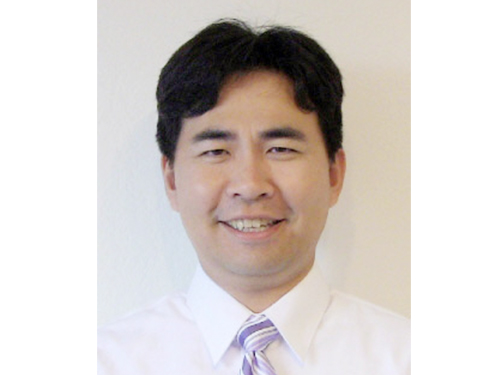 Professor Sung Yong Kim Presents a Keynote Speech at the International Ocean Color Science Meeting (IOCS) 2015
Professor Sung Yong Kim of the Mechanical Engineering Department at KAIST delivered a keynote speech at the International Ocean Color Science Meeting (IOCS) 2015 held in San Francisco on June 15-18, 2015. His speech was entitled “Research and Applications Using Sub-mesoscale GOCI (Geostationary Ocean Color Imager) Data.”
The IOCS, organized by the International Ocean Color Coordinating Group (IOCCG), is a community consultation meeting providing communication and collaboration between space agencies and the ocean color community, building strong ties among international representatives of the ocean color communities, and providing a forum for discussion and the evolution of community thinking on a range of issues.
Professor Kim was recognized for his contribution towards the development of remote exploration of sub-mesoscale processes including eddies, fronts, and environmental fluid dynamics.
He also attended the 26th General Assembly of the International Union of Geodesy and Geophysics (IUGG) in Prague, the Czech Republic, on June 22, 2015 and gave a presentation on the sub-mesoscale eddies circulation research.
2015.06.12 View 9574
Professor Sung Yong Kim Presents a Keynote Speech at the International Ocean Color Science Meeting (IOCS) 2015
Professor Sung Yong Kim of the Mechanical Engineering Department at KAIST delivered a keynote speech at the International Ocean Color Science Meeting (IOCS) 2015 held in San Francisco on June 15-18, 2015. His speech was entitled “Research and Applications Using Sub-mesoscale GOCI (Geostationary Ocean Color Imager) Data.”
The IOCS, organized by the International Ocean Color Coordinating Group (IOCCG), is a community consultation meeting providing communication and collaboration between space agencies and the ocean color community, building strong ties among international representatives of the ocean color communities, and providing a forum for discussion and the evolution of community thinking on a range of issues.
Professor Kim was recognized for his contribution towards the development of remote exploration of sub-mesoscale processes including eddies, fronts, and environmental fluid dynamics.
He also attended the 26th General Assembly of the International Union of Geodesy and Geophysics (IUGG) in Prague, the Czech Republic, on June 22, 2015 and gave a presentation on the sub-mesoscale eddies circulation research.
2015.06.12 View 9574